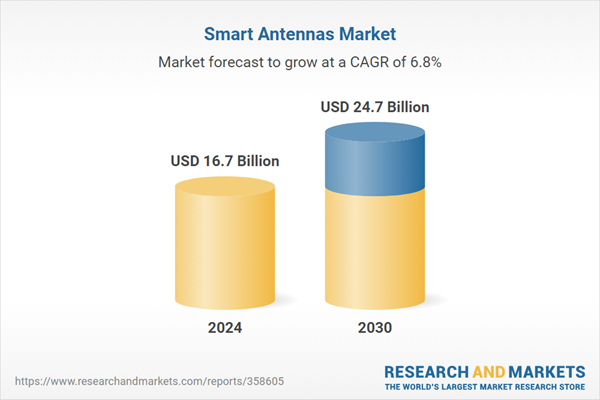The global market for Smart Antennas was valued at USD 16.7 Billion in 2024 and is projected to reach USD 24.7 Billion by 2030, growing at a CAGR of 6.8% from 2024 to 2030. This comprehensive report provides an in-depth analysis of market trends, drivers, and forecasts, helping you make informed business decisions.
Global Smart Antennas Market - Key Trends and Drivers Summarized
Smart Antennas: Revolutionizing Wireless Communication
Smart antennas, also known as adaptive array antennas, represent a significant advancement in wireless communication technology. Unlike traditional antennas, smart antennas can dynamically adjust their radiation patterns to optimize signal reception and transmission. They achieve this through beamforming and spatial filtering techniques, which enable the antenna to focus its energy in specific directions and reduce interference from unwanted sources. This capability is facilitated by an array of individual antenna elements, each connected to a signal processor that controls the phase and amplitude of the signals. By continuously monitoring the signal environment, smart antennas can adapt in real-time, improving signal quality, enhancing capacity, and extending coverage. This adaptability is particularly beneficial in environments with high mobility and varying interference, such as urban areas and mobile networks.What Are the Applications of Smart Antennas?
The applications of smart antennas are diverse and expanding across various sectors. In telecommunications, they are critical in enhancing the performance of cellular networks, including 4G and 5G technologies. Smart antennas help increase network capacity, reduce dropped calls, and improve data rates by optimizing the use of available spectrum. They are also integral to wireless local area networks (WLANs) and Wi-Fi systems, where they enhance connectivity and user experience in crowded environments like airports, stadiums, and offices. In the defense sector, smart antennas are used in radar systems and electronic warfare to detect and track targets more accurately and to avoid jamming. Additionally, they play a vital role in satellite communications, ensuring reliable links in space missions and global broadcasting services. The automotive industry leverages smart antennas in advanced driver-assistance systems (ADAS) and vehicle-to-everything (V2X) communication to improve road safety and traffic management.What Are the Recent Innovations in Smart Antenna Technology?
Recent innovations in smart antenna technology are driving significant improvements in wireless communication systems. One of the key trends is the integration of artificial intelligence (AI) and machine learning algorithms to enhance the adaptability and efficiency of smart antennas. These technologies enable more precise beamforming and interference mitigation by learning from the signal environment and predicting optimal configurations. Another innovation is the development of massive MIMO (multiple-input, multiple-output) systems, which employ a large number of antenna elements to significantly boost capacity and spectral efficiency. Advancements in materials science have also led to the creation of flexible and miniaturized smart antennas, which can be integrated into wearable devices and Internet of Things (IoT) applications. Additionally, the deployment of smart antennas in mmWave (millimeter wave) frequencies is expanding the possibilities for high-speed, short-range communication in 5G and beyond, offering unprecedented data rates and connectivity.What Factors Are Driving the Growth in the Smart Antennas Market?
The growth in the smart antennas market is driven by several factors. The increasing demand for high-speed mobile internet and the proliferation of connected devices are primary drivers, necessitating more efficient and reliable communication networks. The deployment of 5G technology, with its requirements for higher capacity and lower latency, is significantly boosting the demand for smart antennas. Additionally, the expansion of IoT applications across various industries, including healthcare, automotive, and smart cities, is further propelling market growth. Technological advancements in AI and machine learning are enhancing the capabilities of smart antennas, making them more efficient and effective. Regulatory support for spectrum allocation and the push for improved network infrastructure in emerging markets are also contributing to the market expansion. Furthermore, the increasing investment in research and development by major industry players to innovate and reduce costs is making smart antenna technology more accessible and widespread. These factors collectively drive the dynamic growth of the smart antennas market, highlighting its critical role in the future of wireless communication.Report Scope
The report analyzes the Smart Antennas market, presented in terms of market value (USD Thousand). The analysis covers the key segments and geographic regions outlined below.Segments
Type (Switched Multibeam Antenna, Adaptive Array Antenna); Technology (MIMO (Multiple Input Multiple Output), MISO (Multiple Input Single Output), SIMO (Single Input Multiple Output)); Application (Cellular System, WiFi System, WiMAX Systems, Other Applications).Geographic Regions/Countries
World; United States; Canada; Japan; China; Europe (France; Germany; Italy; United Kingdom; and Rest of Europe); Asia-Pacific; Rest of World.Key Insights:
- Market Growth: Understand the significant growth trajectory of the Switched Multibeam Antenna segment, which is expected to reach $15.8 Billion by 2030 with a CAGR of a 7.3%. The Adaptive Array Antenna segment is also set to grow at 5.9% CAGR over the analysis period.
- Regional Analysis: Gain insights into the U.S. market, valued at $4.5 Billion in 2024, and China, forecasted to grow at an impressive 6.4% CAGR to reach $3.9 Billion by 2030. Discover growth trends in other key regions, including Japan, Canada, Germany, and the Asia-Pacific.
Report Features:
- Comprehensive Market Data: Independent analysis of annual sales and market forecasts in USD from 2024 to 2030.
- In-Depth Regional Analysis: Detailed insights into key markets, including the U.S., China, Japan, Canada, Europe, Asia-Pacific, Latin America, Middle East, and Africa.
- Company Profiles: Coverage of major players such as ArrayComm LLC, Broadcom Ltd., CalAmp Corporation, Cobham PLC, Intel Corporation and more.
- Complimentary Updates: Receive free report updates for one year to keep you informed of the latest market developments.
Why You Should Buy This Report:
- Detailed Market Analysis: Access a thorough analysis of the Global Smart Antennas Market, covering all major geographic regions and market segments.
- Competitive Insights: Get an overview of the competitive landscape, including the market presence of major players across different geographies.
- Future Trends and Drivers: Understand the key trends and drivers shaping the future of the Global Smart Antennas Market.
- Actionable Insights: Benefit from actionable insights that can help you identify new revenue opportunities and make strategic business decisions.
Key Questions Answered:
- How is the Global Smart Antennas Market expected to evolve by 2030?
- What are the main drivers and restraints affecting the market?
- Which market segments will grow the most over the forecast period?
- How will market shares for different regions and segments change by 2030?
- Who are the leading players in the market, and what are their prospects?
Some of the 44 major companies featured in this Smart Antennas market report include:
- ArrayComm LLC
- Broadcom Ltd.
- CalAmp Corporation
- Cobham PLC
- Intel Corporation
- Motorola Solutions, Inc.
- Nokia Corporation
- Sierra Wireless, Inc.
Table of Contents
I. METHODOLOGYII. EXECUTIVE SUMMARY2. FOCUS ON SELECT PLAYERSIII. MARKET ANALYSISIV. COMPETITION
1. MARKET OVERVIEW
3. MARKET TRENDS & DRIVERS
4. GLOBAL MARKET PERSPECTIVE
UNITED STATES
CANADA
JAPAN
CHINA
EUROPE
FRANCE
GERMANY
ITALY
UNITED KINGDOM
REST OF EUROPE
ASIA-PACIFIC
REST OF WORLD
Companies Mentioned (Partial List)
A selection of companies mentioned in this report includes, but is not limited to:
- ArrayComm LLC
- Broadcom Ltd.
- CalAmp Corporation
- Cobham PLC
- Intel Corporation
- Motorola Solutions, Inc.
- Nokia Corporation
- Sierra Wireless, Inc.
Table Information
| Report Attribute | Details |
|---|---|
| No. of Pages | 203 |
| Published | April 2025 |
| Forecast Period | 2024 - 2030 |
| Estimated Market Value ( USD | $ 16.7 Billion |
| Forecasted Market Value ( USD | $ 24.7 Billion |
| Compound Annual Growth Rate | 6.8% |
| Regions Covered | Global |









